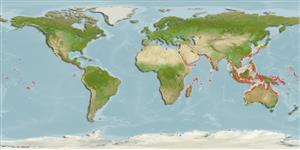Elasmobranchii (tubarões e raias) (sharks and rays) >
Myliobatiformes (Stingrays) >
Gymnuridae (Butterfly rays)
Etymology: Gymnura: Greek, gymnos = naked + Greek, oura = tail (Ref. 45335).
More on author: Shaw.
Environment: milieu / climate zone / depth range / distribution range
Ecologia
marinhas demersal; intervalo de profundidade ? - 80 m (Ref. 9773). Tropical
Indo-Pacific: Persian Gulf (Ref. 68964), Red Sea to French Polynesia, north to Japan. Also reported from Persian Gulf (Ref. 96002).
Length at first maturity / Tamanho / Peso / Idade
Maturity: Lm 48.0 range ? - ? cm
Max length : 250 cm WD macho/indeterminado; (Ref. 30573)
Ovoviviparous (Ref. 50449). Caught often in demersal trawls, and occasionally by trammel net. Utilized for its meat, but of limited value due to its typically small size (Ref. 58048).
Exhibit ovoviparity (aplacental viviparity), with embryos feeding initially on yolk, then receiving additional nourishment from the mother by indirect absorption of uterine fluid enriched with mucus, fat or protein through specialised structures (Ref. 50449). Distinct pairing with embrace (Ref. 205). Gives birth to litters of up to 7 pups; born at 24-26 cm WD (Ref. 58048).
Sommer, C., W. Schneider and J.-M. Poutiers, 1996. FAO species identification field guide for fishery purposes. The living marine resources of Somalia. FAO, Rome. 376 p. (Ref. 30573)
Categoria na Lista Vermelha da IUCN (Ref. 130435: Version 2024-1)
Ameaça para o homem
Harmless
Utilização humana
Pescarias: espécies comerciais
Ferramentas
Relatórios especiais
Descarregue XML
Fontes da internet
Estimates based on models
Preferred temperature (Ref.
123201): 25.2 - 29.2, mean 28.5 °C (based on 2718 cells).
Phylogenetic diversity index (Ref.
82804): PD
50 = 0.5000 [Uniqueness, from 0.5 = low to 2.0 = high].
Bayesian length-weight: a=0.00617 (0.00391 - 0.00973), b=3.06 (2.92 - 3.20), in cm total length, based on LWR estimates for this species & (Sub)family-body (Ref.
93245).
Nível Trófico (Ref.
69278): 3.8 ±0.59 se; based on food items.
Resiliência (Ref.
120179): Muito baixo, tempo mínimo de duplicação da população maior que 14 anos (Fec=1-6).
Fishing Vulnerability (Ref.
59153): Moderate vulnerability (43 of 100).
Nutrients (Ref.
124155): Calcium = 18.6 [5.1, 96.5] mg/100g; Iron = 0.633 [0.154, 1.772] mg/100g; Protein = 22.5 [19.0, 25.4] %; Omega3 = 0.159 [0.044, 0.512] g/100g; Selenium = 54.2 [15.2, 177.9] μg/100g; VitaminA = 9.18 [3.08, 26.74] μg/100g; Zinc = 0.584 [0.276, 1.078] mg/100g (wet weight);
